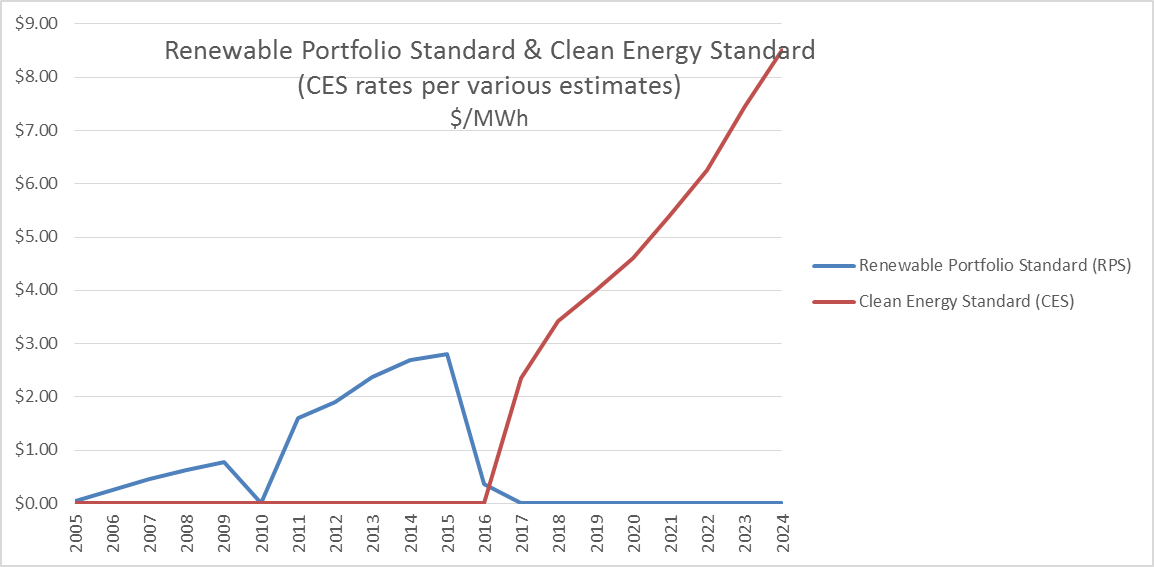We have received a number of questions from customers about NY State’s Clean Energy Standard (CES). In this article we explain the program, we compare what you can expect to pay to what you’ve been paying for the program that the CES replaces, and what to look for on your invoice.
What is the Clean Energy Standard?
The Clean Energy Standard (CES) made news at the end of August of 2016 after the State regulation was approved by the NY Public Service Commission (PSC). Utility Dive, Bloomberg and The Huffington Post reported on various aspects of the NY Department of Public Service’s (DPS’) decision to mandate an increase in renewable energy sources and to provide guaranteed income for three struggling upstate nuclear power plants.
According to a Utility Dive article titled “Updated: New York PSC approves 50% clean energy standard, nuclear subsidies”:
- The unanimous decision will direct $965 million in additional revenue to the Fitzpatrick, Ginna and Nine Mile plants over the first two years of the program, Bloomberg reports, with adjustments every two years until 2029.
- The state has set a aggressive implementation schedule, requiring utilities and energy service companies to begin serving up 26.31% renewable power starting next year, and will grow to 30.54% by 2021.
According to the DPS’ report on key cost findings (available here):
- Even in this period of lower electricity prices due to historically low natural gas prices, New York can meet its clean energy targets with less than a 1% impact on electricity bills (or less than $1 per month for the typical residential customer)
- In the near‐term, under base case assumptions – $1.3 billion public investment – Generation of emission‐free electricity, which produces $3.1 billion in carbon benefits (based on the U.S. EPA Social Cost of Carbon as specified the Benefit‐ Cost Analysis Order) – Hence, the net program impact is a benefit of $1.8 billion 4 Results Summary
- Alignment with Reforming the Energy Vision and the Clean Energy Fund – Reduce ratepayer collections over time – Reduce the costs of clean energy technologies
- REV will cause expansion of distributed resources and enable integration with the electric grid in a way that decreases system costs and facilitates renewable generation
What impact will the Clean Energy Standard have on your costs?
No matter whether you buy electricity supply from a third party supplier (so-called ESCO) or from your local utility, you will begin to see a separate charge on your invoice to recover the costs of the Clean Energy Standard. We expect the initial impact on your invoice to be in the $0.003/kWh range. That cost impact is likely to increase over the next 10 to 20 years. As you can see in the graph below, the CES may end up costing customers anywhere between $0.008/kWh to even, possibly, over a penny (depending on the year and the estimate).
There is an important item to note, however. Take note of the following graph, which shows a forecast of CES costs as it compares to other programs that rate payers have been paying over the past several years. Note that the NY Renewable Portfolio Standard (which was paid on your distribution utility bill) stopped at the end of 2016 and is being replaced by the CES. So in 2017, energy buyers should not see a significant change or impact on your costs.

There are likely to be legal challenges to the CES implementation, particularly with regard to the payments to the Upstate nuclear plants. For now, the charge is expected to appear on your invoices, so look for a charge on your supplier bill or on your distribution utility bill (if you take electricity supply from your local utility) titled “CES”. Note that the charges that you will see there may differ from utility to utility based on how they are implementing the charges.
Contact us if you need help making sense of your bill. We can provide you with some direction.
Bottom line for energy and financial decision makers: Regulatory changes at the state and federal level can have an impact on your costs and budgets. Assuming that the order holds up in court, there will likely be programs and investment in renewable energy in the state that may unlock opportunities for energy buyers. Let us know if you want to talk more about how to approach these markets and if you want to know how best to manage increased financial exposure to clean energy markets.
